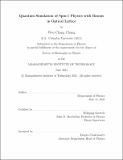Quantum Simulation of Spin-1 Physics with Bosons in Optical Lattice
Author(s)
Chung, Woo Chang
DownloadThesis PDF (8.347Mb)
Advisor
Ketterle, Wolfgang
Terms of use
Metadata
Show full item recordAbstract
Mott insulators of ultracold atoms in optical lattices are widely used as an experimental platform for simulating and studying many-body physics. A topic at the frontier of quantum simulation with Mott insulators is the study of quantum spin models, which are intimately connected to other modern research topics such as the study of quantum phase transitions and quantum thermalization. While quantum spin models are also realized and have traditionally been studied with complex magnetic materials in solid-state physics, the advantages of a cold atom quantum simulator are its wide tunability of model parameters and its capability of preparing a variety of initial states, some of which may not even be possible in solid-state settings.
So far, most of the spin models realized with two-component atom clouds in optical lattices are based on Mott insulators with singly occupied sites. In this thesis, I describe how a Mott insulator with doubly occupied sites gives rise to a qualitatively new spin model. In particular, the addition of the on-site interaction in doubly occupied sites gives rise to a new magnetic anisotropy term known as a single-ion anisotropy, which is inaccessible to models with singly occupied lattice sites. The thesis describes in detail the mapping from a doubly-occupied Mott insulator to an effective spin-1 Heisenberg model with a tunable single-ion anisotropy, along with the details of the experimental setup and the benchmarks that need to met in order to probe low-energy physics such as those studied in the effective spin model. I demonstrate that the experimentally realized spin chains in our optical lattice features coherent spin-1 exchange dynamics and also demonstrate a remarkable interplay between the spin exchange and the single-ion anisotropy term.
The atomic species used is 87Rb, and its internal structure allows the use of a state dependent lattice with an appreciable detuning from resonances. I explain how the state-dependent lattice is used to control the spin-dependent interaction and how it can be used to initialize a two-component atom cloud into a spin Mott insulator, which is a spinful state with no density and spin fluctuation. The spin Mott insulator state is highly interesting because it can be used as an initial state for adiabatic passages to different spinful states, such as the spin superfluid state or an antiferromagnetically textured spin state. I describe the on-going experimental efforts for making adiabatic passages from the spin Mott to the aforementioned target states and provide an outlook on how the experimental setup can be upgraded for a cleaner and more versatile study of spin-1 physics within the optical lattice.
Date issued
2021-06Department
Massachusetts Institute of Technology. Department of PhysicsPublisher
Massachusetts Institute of Technology